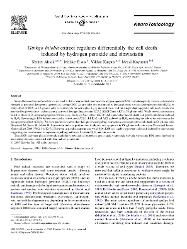| dc.contributor.author | Altıok, Nedret | |
| dc.contributor.author | Ersöz, Melike | |
| dc.contributor.author | Karpuz, Vildan | |
| dc.contributor.author | Koyutürk, Meral | |
| dc.date.accessioned | 2019-06-27T08:06:50Z | |
| dc.date.available | 2019-06-27T08:06:50Z | |
| dc.date.issued | 2006 | |
| dc.identifier.issn | 0161-813X | en_US |
| dc.identifier.issn | 1872-9711 | en_US |
| dc.identifier.uri | https://hdl.handle.net/20.500.12469/1235 | |
| dc.identifier.uri | https://doi.org/10.1016/j.neuro.2005.08.004 | |
| dc.description.abstract | Several human diseases have been associated with the overproduction of reactive oxygen species (ROS) and subsequently various antioxidants emerged as potential therapeutic agents that scavenge ROS. As an oxidative stress model of human disease we used hydrogen peroxide (11202) to study effect of ROS on C6 glioma cells as a surrogate for astrocytes. H2O2 induced dose- and time-dependent apoptotic cell death which was preceded by growth arrest and transiently activated the signalling proteins ATF-2 ERK1/2 and AKT in C6 glioma cells. While several antioxidants failed to block H2O2-induced apoptosis of these cells Ginkgo biloba extract (EGb) totally prevented the cell death and growth inhibition induced by H2O2. Interestingly EGb did not prevent the activation of ATF-2 ERK1/2 and AKT induced by H2O2 excluding the role of these factors in the pro-apoptotic effect of H2O2. We have previously shown that the lipid-lowering drug simvastatin causes apoptotic cell death in C6 glioma cells [Koyuturk M Ersoz M Altiok N. Simvastatin induces proliferation inhibition and apoptosis in C6 glioma cells via c-jun N-terminal kinase. Neurosci Lett 2004 | en_US] |
| dc.description.abstract | 370(2-3):212-7]. However in parallel experiments with H2O2 EGb was unable to prevent cell death induced by simvastatin suggesting the involvement of separate signalling pathways between H2O2 and simvastatin. Thus EGb and other plant flavonoids might have potential as protective agents against apoptosis through scavenging ROS upon cerebral or myocardial diseases associated with free radical generation. (c) 2005 Elsevier Inc. All rights reserved. | en_US] |
| dc.language.iso | eng | en_US |
| dc.publisher | Elsevier Science Bv | en_US |
| dc.rights | info:eu-repo/semantics/closedAccess | en_US |
| dc.subject | Apoptosis | en_US |
| dc.subject | ATF-2 | en_US |
| dc.subject | ERK | en_US |
| dc.subject | Ginkgo biloba | en_US |
| dc.subject | Glioma | en_US |
| dc.subject | Hydrogen peroxide | en_US |
| dc.title | Ginkgo biloba extract regulates differentially the cell death induced by hydrogen peroxide and simvastatin | en_US |
| dc.type | article | en_US |
| dc.identifier.startpage | 158 | en_US |
| dc.identifier.endpage | 163 | |
| dc.relation.journal | Neurotoxicology | en_US |
| dc.identifier.issue | 2 | |
| dc.identifier.volume | 27 | en_US |
| dc.identifier.wos | WOS:000235756500004 | en_US |
| dc.identifier.doi | 10.1016/j.neuro.2005.08.004 | en_US |
| dc.identifier.scopus | 2-s2.0-32244441864 | en_US |
| dc.relation.publicationcategory | Makale - Uluslararası Hakemli Dergi - Kurum Öğretim Elemanı | en_US |
| dc.identifier.pmid | 16185767 | en_US |
















